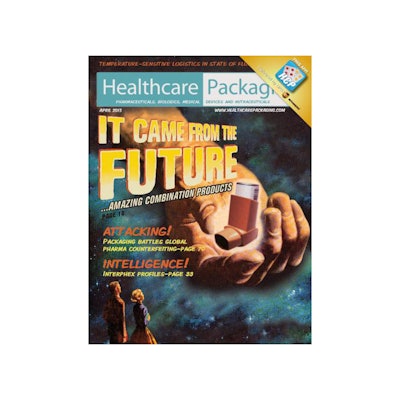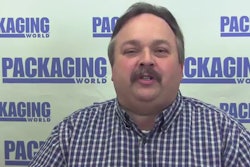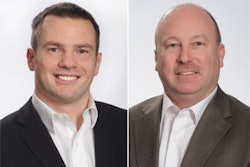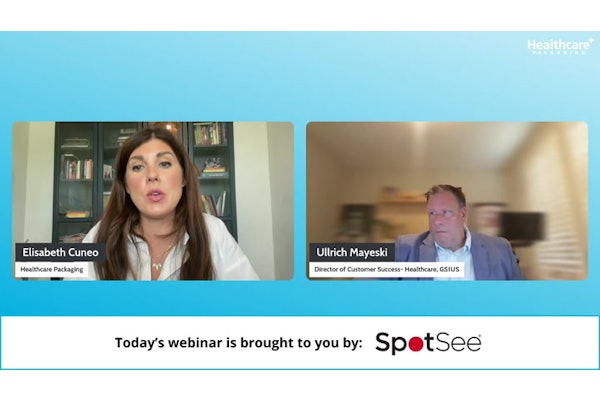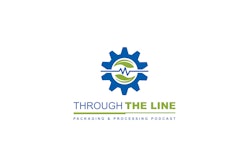In this April Healthcare Packaging print cover story Q&A, Dr. Michael Drues discusses issues pertaining to the future of medicine, beginning with this focus on combination products.
Healthcare Packaging (HCP): The U.S. Food and Drug Administration’s Office of Combination Products was formed in late 2002. Since then there have been many developments and new treatments in this area. Can you walk us through what’s been going on and what OCP’s role is in getting products to market?
Dr. Michael Drues: From a regulatory perspective, when it comes to combination products, the first question that one needs to ask is, “What is the product’s primary mode of action, or PMOA? PMOA essentially means, when you put your product into a patient and how does it work? Is it mechanical or electrical? If so, then the product is acting primarily as a medical device. Is it pharmacological or biochemical? If so, then the product is acting primarily as a pharmaceutical (i.e., a drug). Is it biological? If so, then the product is acting primarily as a biologic.
PMOA determines the lead center at the FDA—either CDER (drugs), CBER (biologics) or CDRH (medical devices). The lead center will ultimately have “control” over the approval process of the product. For many reasons, it is ideal to have CDRH designated as the lead center. Here’s how you can do it: From a strategy perspective, you always want to argue the PMOA is mechanical or electrical so CDRH is designated the lead center, even if you have a drug-biologic combination, i.e., what some now call an Antibody-Drug Conjugate (or ADC), and there is no “obvious” medical device component as CDRH tends to have fewer regulatory challenges. But there are no guarantees. It’s wise to have backup or contingency plans.
On the surface, the PMOA seems like a straightforward concept. However, reality is far less simple. For simple products like the drug-eluting stent, one can easily argue (as was done in the past) that the PMOA of the DES is mechanical, in that the primary action is the stent mechanically “holding open” the artery while the action of the drug on the stent is secondary in that it keeps the artery open over time. Whether you agree with the logic of this argument is now largely a moot point as the precedent has already been set.
However, in the future we will be using far more complex combination products, the quintessential example being tissue engineering. For example, what is the primary mode of action of a tissue-engineered blood vessel or indeed of a tissue-engineered human heart? Is it mechanical? Pharmacological? Biological? More importantly, does it even make sense to ask such a question? In other words, does it make sense to try to separate mechanics, biochemistry, and molecular biology? Taken to the extreme, is not the human body a combination product? If so, then from a regulatory perspective, the first question we must ask is “What is the PMOA of the human body?”
A few years ago, OCP spent considerable time and effort trying to develop a “better” definition of PMOA. When it was published in the Federal Register, it was some 15 pages long, which begs the question, “if we need 15 pages to define anything, perhaps that’s part of the problem! After all, as Einstein said, “If we can’t explain something simply, we don’t understand it well enough.” More importantly, some view those efforts largely as a waste of time. Why?
Because developing a “better” definition of PMOA is akin to rearranging the deck chairs on the Titanic—sooner or later, the ship is going down! Some within FDA are troubled by trying to apply the concept of the PMOA to more complex products. For better or worse, PMOA is still what appears in the Code of Federal Regulations (CFR). Many complain about what FDA requires, but FDA can only do what Congress instructs them to do. And if you think it’s difficult to change FDA, that’s nothing compared to Congress!
Interestingly enough, the OCP does not regulate anything. The OCP helps, for example, when a company submits what’s called a request for designation, or RFD. The company makes a case that the PMOA of their combination product is device, drug, or biologic. OCP will consult with the other appropriate centers. They will agree or disagree with the company, and they will assign the FDA lead center. One of the most important roles of the OCP is to serve as a monitor of sorts as drug, device, and biologics folks do not always speak the same language. OCP tries to bridge some of those gaps.
By the way, this is not limited to the FDA. How do you get a medical device company and a biotech company, for example, to come together to develop a combination product? There are huge knowledge gaps between industries. Education, in my opinion, is one of the biggest challenges in an area like combination products, which is, as I have said publicly many times over the past 20 years, clearly the future of medicine. I don’t think there is any doubt about that anymore.
HCP: Why do you believe that to be the case and what are the challenges with advancing combination products?
Drues: Slowly the rest of the world is coming around to the notion that combination products represent the future but it is taking a long time. Here’s an interesting statistic from my combination product seminar: In 2012, an estimated 30 percent of all new healthcare products under development were “combination products” involving medical devices embedded with pharmaceutical or biologics components.
As for the biggest challenges, they are not what many may think. It is not the technology, the regulation, the intellectual property, or the manufacturing. While those are all challenges, the biggest hurdle is what’s called “convergence.” How do you get engineers, pharmacologists, and molecular biologists, whether they are in industry, at FDA, or in academic research, to come together to have an intelligent conversation about the synergistic benefits of combining their technologies when they may not understand the other technologies and they don’t even speak the same language?
Here’s a simple example: Engineers look at the world from an F=ma perspective, whereas molecular biologists look at the world from an A, T, G, and C perspective. There is not a lot of overlap between F=ma and A, T, G, and C. And for those not familiar with both references, that proves my point!
Most people may know lot about medical devices, or about drugs, or about biologics, but there are not a lot of people who have enough knowledge about all of these different areas to put them together in interesting and beneficial ways. So that, in my opinion, is one of the things that’s really holding us back compared to what we could be doing [to advance medical treatment].
HCP: What are some of the exciting advances that you see in combination products and their place in the future of medicine?
Drues: Combination products are clearly an area that is gaining in momentum. The drug-eluting stent remains the best-known example of a combination product, yet that technology is very much still in its infancy. I want to be able to put many different drugs and biologics all on a single medical device like a stent. I am using a stent as a metaphor for almost any medical device. For example, monoclonal antibodies, a type of therapeutic protein sometimes called a biotech-drug, can be put on different medical devices to accomplish different objectives. What we have been doing thus far in drug-eluting stents has been very simple, almost primitive compared to what we could be and will be doing in the future.
What should be of interest to packaging professionals are issues like sterility and shelf life. Drugs are pretty stable molecules. Biologics on the other hand are very finicky, inherently unstable molecules. How do you sterilize a plain old bare metal stent? You can hit it with heat, gamma, ETO, and so forth, because you are not going to change the stent. But once you put a drug on it, or especially once you put a biologic on it, all bets are off. We don’t sterilize most drugs—we manufacture them in an aseptic process. When it comes to sterilizing a biologic, such as a monoclonal antibody—or a gene inside a virus (i.e., gene therapy) on a stent, how do we do it? Does it make sense to even try, at least in the conventional sense? For biologics, sometimes changing the temperature or the ambient lighting is enough to denature the protein. So how do you sterilize it? There is a tremendous amount of education that has to happen here, not just in industry, but at FDA as well.
Now lets think of shelf life. The whole notion of putting a protein or some form of gene therapy or a stem cell (i.e., an endothelial progenitor cell) on a device in a package and placing it on a shelf for weeks or months is nuts. One thing I think we will see more and more in the future is that many of these products are not going to be combined in a manufacturing facility, but they are going to be packaged separately and combined at the patient’s bedside, a so-called e(2) combination product. In January 2013, FDA issued a new guidance [see sidebar] meant to provide clarification on cGMP requirements for e(2) combination products, but that’s still very primitive compared to what I’m describing.
Here’s an example: In cardiology, just before the cardiologist inserts the stent—and again this is true for all these kinds of products, not just cardiology—the medical team is going to dip the stent in a little vial that contains monoclonal antibodies. Then that stent is going to be designed to attract those antibodies like a sponge, and hold them.
How do you make sure you have good coverage? One way to do it could be to design the stent to be white with the antibody solution red so that when you dunk this stent into the vial it could work similarly to litmus paper in that you could employ a color scale on the side of your bottle that tells the physician what the concentration (a.k.a. dosage) is. He or she pulls it out and can dunk it in again to attain the desired dosage of antibody for that particular patient. Can you say pharmacogenomics for medical devices?
Another trend is a concept I coined at FDA called “multiple combination product,” where we have multiple drugs and biologics all being delivered by a single device. We are not there yet clinically. We don’t even have many of those products in development, but that’s clearly a trend for the future. These could be in the form of a liquid, a solid, a powder, or even a gel.
We can deliver these multiple combination products in many different ways. We could even use one combination product to deliver another combination product! For example, we could use a drug-eluting balloon catheter (or what I call a “biotherapeutic-carrying vehicle”) instead of a stent. We can deliver gene therapy or nanoparticles, the mechanical equivalent of gene therapy, or a drug inside of a nanoparticle using this drug-eluting balloon and now we have one combination product delivering another combination product. That, as we would say in Boston, is wicked cool!
The bottom line is simple: These are all solvable problems if we think differently. That’s the biggest challenge. We have got to move beyond what we have been doing in the past. We have got to be willing to think differently.
Dr. Michael Drues is president of Grafton, MA-based Vascular Sciences, an education, training, and consulting company. He received his B.S., M.S., and Ph.D. degrees in Biomedical Engineering from Iowa State University. He has worked for and consulted with leading medical device, pharmaceutical, and biological companies, and for the FDA, Health Canada, the U.S. and European Patent Offices, the Centers for Medicare & Medicaid Services, and other regulatory and governmental agencies worldwide. He is an internationally recognized expert and keynote speaker on cutting-edge medical technologies and regulatory affairs and teaches graduate courses at several universities and medical schools. His specialties include combination products, clinical trial design, regulatory strategy, pharmacogenomics/personalized medicine, and business development. He can be reached on Linkedin®, by phone at 508.887.9486, and by e-mail at [email protected].
